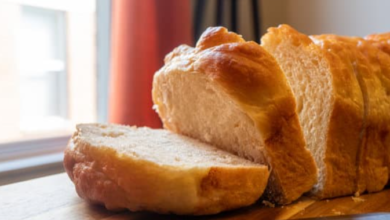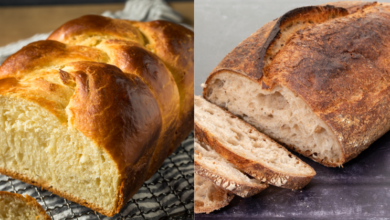Ciabatta Vs Brioche: Who Will Win?
What To Know
- Brioche’s soft and eggy texture makes it a decadent choice for French toast, resulting in a crispy exterior and a fluffy interior.
- If you prefer a rustic, hearty bread with a chewy texture and a mild flavor, ciabatta is an excellent option.
- For a rich, buttery bread with a soft, velvety crumb and a slightly sweet flavor, brioche is a delightful choice.
In the realm of bread artistry, ciabatta and brioche stand as two beloved staples, each boasting a unique character and culinary appeal. From their distinct textures to their diverse applications, these breads have captured the hearts of bakers and foodies alike. In this comprehensive guide, we delve into the fascinating world of ciabatta vs brioche, exploring their origins, characteristics, uses, and the ultimate question: which bread reigns supreme?
Origins and History
Ciabatta
Ciabatta, an Italian bread originating in the Veneto region, first emerged in the 1980s as a response to the popularity of French baguettes. Its name, derived from the Italian word for “slipper,” aptly describes its flat, elongated shape.
Brioche
Brioche, a French pastry dough, has a rich history dating back to the 16th century. It originated in the Normandy region and has since become a beloved staple in French cuisine and beyond. Its name is believed to stem from the Old French word “broyer,” meaning “to knead.”
Characteristics: Texture and Flavor
Ciabatta
- Texture: Ciabatta is renowned for its airy, open crumb with large, irregular holes. This unique texture is achieved through a high hydration dough and a long fermentation process.
- Flavor: Ciabatta has a mild, slightly tangy flavor with a hint of sweetness. Its rustic appearance and chewy texture make it a versatile bread for various culinary applications.
Brioche
- Texture: Brioche is characterized by its soft, buttery, and slightly dense crumb. The addition of eggs and butter to the dough results in a rich and velvety texture.
- Flavor: Brioche has a sweet and buttery flavor with a hint of yeastiness. Its golden-brown crust adds a delightful crunch to each bite.
Culinary Applications
Ciabatta
- Sandwiches: Ciabatta’s sturdy texture makes it an ideal bread for hearty sandwiches. Its open crumb allows for generous fillings and sauces.
- Bruschetta: Ciabatta slices are perfect for bruschetta, topped with fresh tomatoes, basil, and olive oil.
- Soups and stews: Ciabatta’s chewy texture complements soups and stews, providing a satisfying accompaniment to rich broths.
Brioche
- Pastries: Brioche dough is commonly used in pastries such as croissants, pain au chocolat, and cinnamon rolls. Its buttery richness enhances the flavor and texture of these delectable treats.
- French toast: Brioche’s soft and eggy texture makes it a decadent choice for French toast, resulting in a crispy exterior and a fluffy interior.
- Burgers: Brioche buns have become increasingly popular for gourmet burgers, adding a touch of sweetness and softness to the classic dish.
Health Benefits
Ciabatta
- Lower glycemic index: Ciabatta’s high hydration and long fermentation process result in a lower glycemic index, making it a healthier option for those managing blood sugar levels.
- Rich in fiber: Ciabatta contains dietary fiber, which supports digestive health and promotes satiety.
Brioche
- High in protein: Brioche’s egg content provides a good source of protein, essential for building and repairing tissues.
- Contains vitamins and minerals: Brioche is a source of vitamins and minerals, including B vitamins, selenium, and zinc.
Which Bread Is Right for You?
The choice between ciabatta and brioche ultimately depends on your personal preferences and culinary needs. If you prefer a rustic, hearty bread with a chewy texture and a mild flavor, ciabatta is an excellent option. For a rich, buttery bread with a soft, velvety crumb and a slightly sweet flavor, brioche is a delightful choice.
Beyond the Basics: Specialty Variations
Ciabatta
- Ciabatta con Pomodoro: Ciabatta dough topped with crushed tomatoes, garlic, and herbs, creating a flavorful and savory bread.
- Ciabatta al Formaggio: Ciabatta dough infused with grated cheese, resulting in a cheesy and aromatic bread.
Brioche
- Brioche Feuilletée: A layered brioche dough that resembles a croissant, offering a combination of flaky and buttery textures.
- Brioche Nanterre: A large, round brioche with a soft and airy crumb, perfect for slicing and sharing.
Final Note: A Culinary Odyssey
Ciabatta and brioche, each with their unique characteristics and culinary applications, have established themselves as indispensable staples in the world of bread. Whether you prefer the rustic charm of ciabatta or the opulent richness of brioche, there is a bread here to satisfy every palate and culinary adventure. Embrace the diversity of these breads and explore their endless possibilities, from hearty sandwiches to decadent pastries.
Frequently Discussed Topics
Q: Which bread has a higher calorie content, ciabatta or brioche?
A: Brioche generally has a higher calorie content than ciabatta due to its higher fat content from butter and eggs.
Q: Is ciabatta gluten-free?
A: Traditional ciabatta is not gluten-free as it is made with wheat flour. However, gluten-free ciabatta options are available for those with gluten sensitivities or allergies.
Q: Can I use ciabatta and brioche dough interchangeably in recipes?
A: While ciabatta and brioche dough share some similarities, they have distinct characteristics and may not be suitable substitutes for each other in all recipes.




